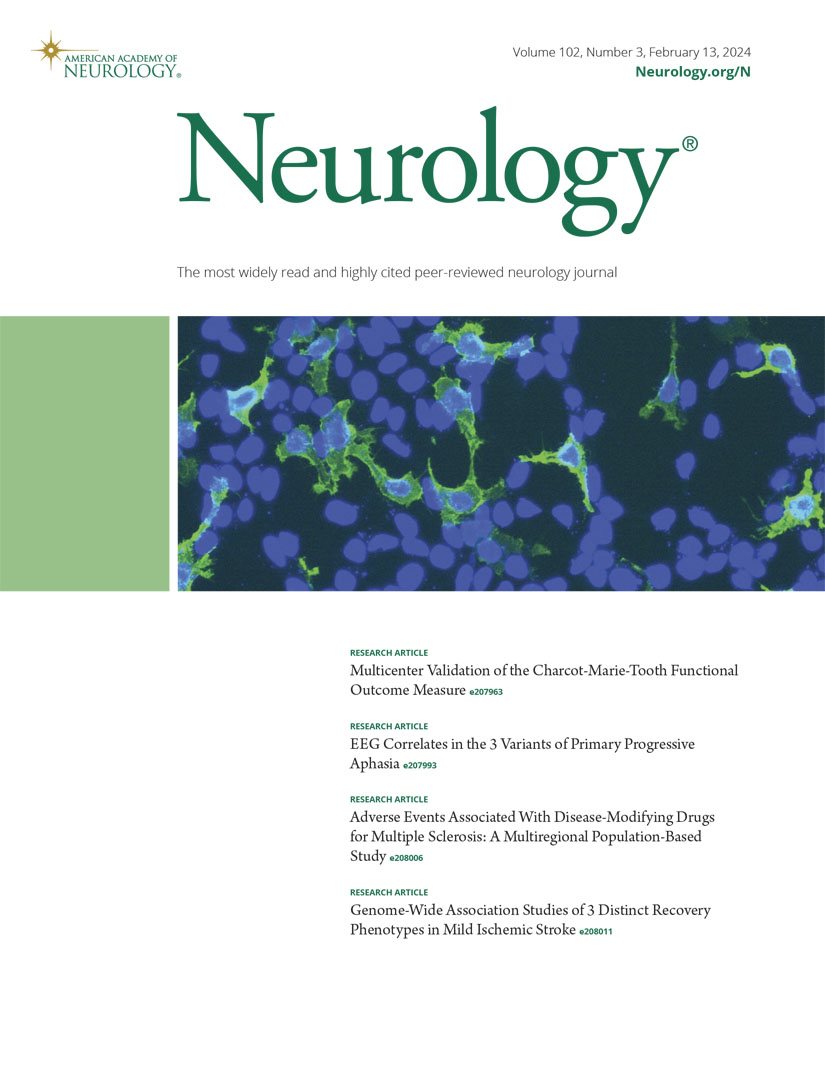Development and Adaptive Function in Individuals With SCN2A-Related Disorders.
IF 8.5
1区 医学
Q1 CLINICAL NEUROLOGY
引用次数: 0
Abstract
BACKGROUND AND OBJECTIVES Developmental impairment is common in individuals with SCN2A-related disorders, although descriptions are limited. We aimed to determine trajectories and outcomes of development and adaptive function. METHODS This was a mixed retrospective cross-sectional study of individuals from an international SCN2A Natural History Study, who had neurologic/neurodevelopmental disorders due to an SCN2A variant. Individuals with SCN2A intragenic variants were grouped into early-onset (EO) and late-onset (LO) phenotypic groups; those with SCN2A-containing 2q24.3 copy number variants (CNVs) were considered separately. We collected medical and developmental history from parents/caregivers and medical records. Adaptive function and behavior were characterized using functional classification system levels and Vineland Adaptive Behavior Scales-3 (VABS-3) Parent/Caregiver Form. We repeated analyses on individuals with variants known to result in gain-of-function (GOF, typically EO phenotypes) or loss-of-function (LOF, typically LO phenotypes). RESULTS A total of 100 individuals (age 0.1-21.9 years, 39% female) were studied. Phenotypic groups were EO (n = 44), LO (n = 48), and 2q24.3 CNV (n = 8). Developmental delay/intellectual disability was present in 91 of 100, and 23 of 80 individuals (29%) older than 2 years had autism spectrum disorder. Of people older than the typical age for skill attainment, 59 of 95 (62%) could sit and 48 of 88 (55%) could walk. In addition, 27 of 86 individuals (31%) spoke more than 1-5 single words, and 24 of 74 (32%) followed two-step commands. Median VABS-3 Adaptive Behavior Composite (ABC) scores were as follows: the EO phenotypic group had a score of 56 (range 21-110), the LO phenotypic group had a score of 45 (range 20-89), and 5 of 6 with a 2q24.3 CNV had an ABC score of <45. The EO phenotypic group had 3 distinct subgroups, consistent with "benign," "intermediate," and "severe" definitions previously published. The LO phenotypic group showed a continuum of severity, without distinct clusters. However, clinically relevant differences in motor function were evident when subgrouped by seizure-onset age; a lower proportion with earlier seizure onset (age <18 months) were independently ambulant than those with later onset or no seizures (5/15 [33%] vs 10/12 [83%] vs 14/15 [93%], p < 0.01). Analyses of individuals with confirmed GOF/LOF variants (n = 57) showed similar results to the EO/LO analyses. DISCUSSION The spectrum of developmental impairments and adaptive function in SCN2A-related disorders is extremely broad. Phenotypic subgroups provide prognostic information and critically inform clinical trial design.scn2a相关疾病患者的发育和适应功能
背景与目的发育障碍在scn2a相关疾病患者中很常见,但描述有限。我们的目的是确定发展和适应功能的轨迹和结果。方法:这是一项来自国际SCN2A自然史研究的混合回顾性横断面研究,这些个体因SCN2A变异而患有神经系统/神经发育障碍。携带SCN2A基因内变异的个体被分为早发型(EO)和晚发型(LO)表型组;那些含有2q24.3拷贝数变异(CNVs)的scn2a被单独考虑。我们收集了父母/照顾者的病史和发展史以及医疗记录。采用功能分类系统等级和Vineland适应行为量表-3 (VABS-3)家长/照顾者表对适应功能和行为进行表征。我们对已知导致功能获得(GOF,典型的EO表型)或功能丧失(LOF,典型的LO表型)的变异个体进行了重复分析。结果共调查100例患者,年龄0.1 ~ 21.9岁,其中女性39%。表型组为EO组(n = 44)、LO组(n = 48)和2q24.3 CNV组(n = 8)。100人中有91人存在发育迟缓/智力障碍,80人中有23人(29%)大于2岁患有自闭症谱系障碍。在超过获得技能的典型年龄的人中,95人中有59人(62%)能坐,88人中有48人(55%)能走。此外,86人中有27人(31%)说了超过1-5个单词,74人中有24人(32%)遵循了两步命令。VABS-3适应行为综合评分中位数如下:EO表型组评分为56分(范围21-110),LO表型组评分为45分(范围20-89),6例2q24.3 CNV患者中有5例ABC评分<45。EO表型组有3个不同的亚组,与先前发表的“良性”、“中度”和“严重”定义一致。LO表型组表现出连续的严重程度,没有明显的集群。然而,按癫痫发作年龄分组时,运动功能的临床相关差异是明显的;发病早(年龄<18个月)患儿独立活动的比例低于发病晚或无发作患儿(5/15 [33%]vs 10/12 [83%] vs 14/15 [93%], p < 0.01)。对已确诊的GOF/LOF变异个体(n = 57)的分析结果与EO/LO分析结果相似。scn2a相关疾病的发育障碍和适应性功能范围非常广泛。表型亚组提供预后信息,并为临床试验设计提供重要信息。
本文章由计算机程序翻译,如有差异,请以英文原文为准。
求助全文
约1分钟内获得全文
求助全文
来源期刊

Neurology
医学-临床神经学
CiteScore
12.20
自引率
4.00%
发文量
1973
审稿时长
2-3 weeks
期刊介绍:
Neurology, the official journal of the American Academy of Neurology, aspires to be the premier peer-reviewed journal for clinical neurology research. Its mission is to publish exceptional peer-reviewed original research articles, editorials, and reviews to improve patient care, education, clinical research, and professionalism in neurology.
As the leading clinical neurology journal worldwide, Neurology targets physicians specializing in nervous system diseases and conditions. It aims to advance the field by presenting new basic and clinical research that influences neurological practice. The journal is a leading source of cutting-edge, peer-reviewed information for the neurology community worldwide. Editorial content includes Research, Clinical/Scientific Notes, Views, Historical Neurology, NeuroImages, Humanities, Letters, and position papers from the American Academy of Neurology. The online version is considered the definitive version, encompassing all available content.
Neurology is indexed in prestigious databases such as MEDLINE/PubMed, Embase, Scopus, Biological Abstracts®, PsycINFO®, Current Contents®, Web of Science®, CrossRef, and Google Scholar.
 求助内容:
求助内容: 应助结果提醒方式:
应助结果提醒方式:


